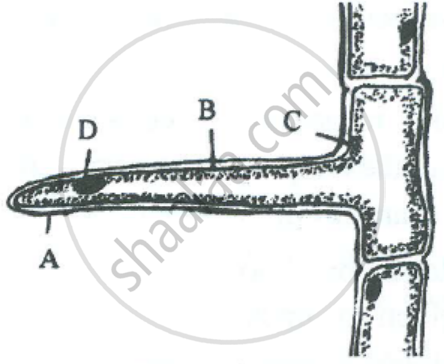Advertisements
Advertisements
Question
The diagram given below represents the results of an experiment conducted on two freshly taken leafy shoots of a herbaceous plant. The lower ends of the shoots dip in ordinary water.
(i) What is the aim of the experiment?
(ii) Some parts of the stem in both the shoots have been removed. Name the conducting tissue in shoot (a) and in shoot (b) that has been removed.
(iii) What are the results of this experiment?

Solution
(i) The aim of the experiment is to show that conduction of water in plants takes place through xylem.
(ii) In shoot, (a) phloem has been removed. In shoot (b), xylem has been removed.
(iii) In shoot (b), xylem has been removed so the leaves are wilted. But in shoot (a), xylem has not been removed so the leaves are turgid.
APPEARS IN
RELATED QUESTIONS
What are root hair? Mention the function performed by the root hair.
How does movement and absorption of water take place through the roots?
Choose the correct answer:
Exudation or bleeding is associated with ___________
The diagram below represents a layer of epidermal cells showing a fully grown root hair. Study the diagram and answer the questions that follow:

Mention one distinct difference between the parts labelled A and B.
Fill in the Blank
Leaves get wilted if _________ is removed from the plant.
Column ‘II’ is a list of items related to ideas in Column ‘I’. Match the term in Column ‘II’ with a suitable idea given in Column ‘I’.
| Column I | Column II |
| (i) Diffusion | (a) The exit or flow of water from the cell to the outer environment. |
| (ii) Xylem | (b) The shrinkage of protoplasm when the cell is kept in a hypertonic solution. |
| (iii) Root pressure | (c) The tissue through which water and mineral salts move upward in a plant. |
| (iv) Isotonic solution | (d) Two solutions which have equal osmotic pressure. |
| (v) Exosmosis | (e) The process by which the molecules of perfume spread in the room when the bottle is open. |
| (vi) Osmosis | (f) The process by which roots absorb water from the soil. |
| (vii) Plasmolysis | (g) The pressure by which water rises up to some feet in a lofty tree. |
| (viii) Hypotonic solution | (h) The concentration of the solution when lower than that of the cell sap. |
Water which is absorbed by roots is transported to aerial parts of the plant through ______
Roots of the plants absorb water from the soil through the process of ____________.
They are pipe-like, consisting of a group of specialised cells. They transport substances and form two-way traffic in plants. Which of the following terms qualify for the features mentioned above?
Water in the root enters due to ______.
